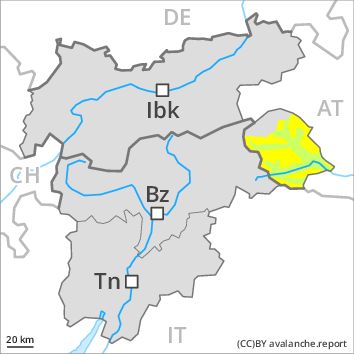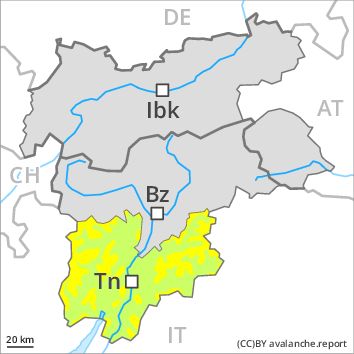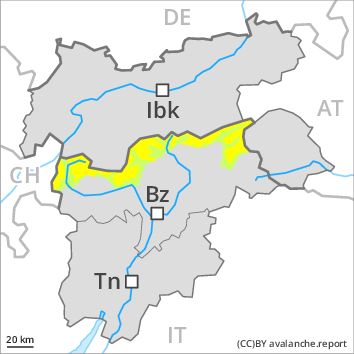Regions
Western Verwall Mountains, Eastern Verwall Mountains, Allgäu Alps, Venediger Range, Eastern Lechtal Alps - Ammergau Alps, Mieming Mountains, Karwendel Mountains, Brandenberg Alps, Western Kitzbühel Alps, Wilder Kaiser Mountains - Waidring Alps, Eastern Kitzbühel Alps, Western Lechtal Alps, Central Lechtal Alps, Grieskogel Mountains

Danger level
Danger Level 3 - Considerable above the treeline
Danger Level 2 - Moderate above the treeline
Avalanche Problem
Wind-drifted snow above the treeline, N-NE-E-W-NW

Fresh wind slabs represent the main danger.
The snow sport conditions outside marked and open pistes are to some extent precarious. The avalanche prone locations are to be found in particular on west to north to east facing wind-loaded slopes. In some cases avalanches are medium-sized and can be released easily even by a single winter sport participant. The number and size of avalanche prone locations will increase with altitude. As the day progresses, individual natural avalanches are possible, in the regions exposed to a lot of wind especially on steep shady slopes. Extensive experience in the assessment of avalanche danger is required.
Dry avalanches can in very isolated cases be released in the old snowpack, mostly by large additional loads, in particular on very steep shady slopes. Transitions from a shallow to a deep snowpack are unfavourable.
In addition a latent danger of gliding avalanches exists.
Snowpack
dp 6: cold, loose snow and wind
dp 5: snowfall after a long period of cold
In some regions 15 to 20 cm of snow. will fall. The sometimes strong wind will transport the fresh snow. Over a wide area wind slabs are lying on old snow containing large grains, in particular on shady slopes. It is lying on surface hoar in some places on shady slopes at low and intermediate altitudes.
The somewhat older wind slabs have bonded quite well with the old snowpack. Faceted weak layers exist deeper in the old snowpack in particular in areas where the snow cover is rather shallow, especially on very steep shady slopes.
Tendency
The avalanche danger will persist.
Regions
Western Tuxer Alps, Eastern Tuxer Alps, Glockturm Range, Weißkugel Range, Gurgler Range, Central Stubai Alps, Northern Zillertal Alps, Silvretta, Samnaun Mountains, Northern Oetz and Stubai Alps

Danger level
Danger Level 2 - Moderate above the treeline
Danger Level 2 - Moderate above the treeline
Avalanche Problem
Wind-drifted snow above the treeline, N-NE-NW

Fresh wind slabs represent the main danger.
Fresh wind slabs are to be evaluated with care and prudence. The avalanche prone locations are to be found in particular in northwest to north to northeast facing aspects. Avalanches are rather small but can be released easily by a single winter sport participant. The number and size of avalanche prone locations will increase with altitude. Experience in the assessment of avalanche danger is required.
Dry avalanches can in very isolated cases be released in the old snowpack, mostly by large additional loads, in particular on very steep shady slopes. Transitions from a shallow to a deep snowpack are unfavourable.
In addition a latent danger of gliding avalanches exists.
Snowpack
dp 6: cold, loose snow and wind
dp 5: snowfall after a long period of cold
In some regions 5 to 10 cm of snow. will fall. The sometimes strong wind will transport the fresh snow. Over a wide area wind slabs are lying on old snow containing large grains, in particular on shady slopes. It is lying on surface hoar in some places on shady slopes at low and intermediate altitudes.
The somewhat older wind slabs have bonded quite well with the old snowpack. Faceted weak layers exist deeper in the old snowpack in particular in areas where the snow cover is rather shallow, especially on very steep shady slopes.
Tendency
The avalanche danger will persist.
Regions
Glockner Range, Eastern Deferegger Alps, Schober Mountains, Lienzer Dolomites, Eastern Rieserferner Mountains

Danger level
Danger Level 2 - Moderate above the treeline
Danger Level 1 - Low above the treeline
Avalanche Problem
Wind-drifted snow above the treeline, N-NE-NW

Fresh wind slabs require caution.
Fresh wind slabs represent the main danger. The avalanche prone locations are to be found in particular in northwest to north to northeast facing aspects. The wind slabs are rather small but in some cases prone to triggering. The number and size of avalanche prone locations will increase with altitude. Experience in the assessment of avalanche danger is required.
Dry avalanches can in very isolated cases be released in the old snowpack, mostly by large additional loads, in particular on very steep shady slopes. Transitions from a shallow to a deep snowpack are unfavourable.
In addition a latent danger of gliding avalanches exists.
Snowpack
dp 6: cold, loose snow and wind
The sometimes storm force wind will transport the old snow. In some cases wind slabs are lying on old snow containing large grains, in particular on shady slopes. It is lying on surface hoar in some places on shady slopes at low and intermediate altitudes.
The somewhat older wind slabs have bonded quite well with the old snowpack. Faceted weak layers exist deeper in the old snowpack in particular in areas where the snow cover is rather shallow, especially on very steep shady slopes.
Tendency
The avalanche danger will persist.
Regions
Gröden Dolomites, Prags Dolomites, Sarntal Alps, Western Pfunderer Mountains, Sexten Dolomites, Eastern Pfunderer Mountains, Western Deferegger Alps, Ortler Range, Ulten Valley, Eastern Nonsberger Alps, Northern Dolomites of Fiemme, Saldurn-Mastaun Ridge

Danger level
Danger Level 2 - Moderate above 2200m
Danger Level 1 - Low above 2200m
Avalanche Problem
Persistent weak layer above 2200m, N-NE-E-NW
Wind-drifted snow above 2200m, N-NE-E-SE-S-NW

The avalanche danger will increase a little during the day.
The fresh wind slabs are to be avoided in particular in terrain where there is a danger of falling. Single backcountry tourers can release avalanches in some places. The older wind slabs can still be released. Caution is to be exercised at their margins in particular, in particular in gullies and bowls, and behind abrupt changes in the terrain. Avalanches can be released in deep layers especially in the vicinity of peaks.
Snowpack
As a consequence of the strong to storm force northwesterly wind the avalanche prone locations will become more prevalent on Saturday. The various wind slabs of last week can be released in isolated cases, but mostly only by large additional loads,. They are to be found in particular adjacent to ridgelines and in gullies and bowls and at high altitudes. The various wind slabs have bonded quite well together. In little used backcountry terrain the avalanche situation is a little more dangerous. Weak layers in the old snowpack are difficult to recognise.
Tendency
The storm force wind will transport the loosely bonded old snow.
Regions
Latemar, Southern Adamello, Primiero - Pale di S. Martino, Adamello - Presanella, Prealps, Northern Brenta - Peller, Cembra Valley, Bondone and Stivo, Vallarsa, Western Nonsberg Alps, Folgaria - Laverone, Southern Brenta, Fassa Valley, Sole, Pejo and Rabbi, Southern Lagorai, Ledro Valley, Northern Lagorai, Maddalene, Paganella, Marzola - Valsugana, Pine' - Mocheni Valley

Danger level
Danger Level 2 - Moderate above the treeline
Danger Level 1 - Low above the treeline
Avalanche Problem
Persistent weak layer above the treeline, N-NE-E-NW
Gliding snow above 2200m, SE-S-SW-W-NW

Moderate, level 2. Wind slabs require caution, especially at elevated altitudes adjacent to ridgelines.
The older wind slabs are mostly easy to recognise but to be assessed with care and prudence. Even single persons can release avalanches in isolated cases, including medium-sized ones, in particular adjacent to ridgelines and in pass areas. The avalanche prone locations are to be found also at transitions from a shallow to a deep snowpack above approximately 2200 m. In steep terrain there is a danger of falling on the icy crust. As a consequence of warming during the day and solar radiation individual mostly small gliding avalanches and moist snow slides are possible. Ski touring and other off-piste activities, including snowshoe hiking, call for meticulous route selection, in particular on steep slopes above approximately 2000 m as well as on wind-loaded slopes. As a consequence of the sometimes strong northerly wind the prevalence of avalanche prone locations will increase as the day progresses.
Snowpack
The wind slabs have formed in particular in gullies and bowls, and behind abrupt changes in the terrain. These are bonding only slowly with the old snowpack in particular on steep shady slopes above the tree line. Faceted weak layers exist deep in the old snowpack at high altitude, especially on northwest, north and northeast facing slopes in areas where the snow cover is rather shallow. The snowpack will be moist at low and intermediate altitudes.
Tendency
As a consequence of the sometimes strong northerly wind the prevalence and size of the avalanche prone locations will increase on Sunday. In addition a latent danger of gliding avalanches exists, in particular on steep grassy slopes below approximately 2200 m.
Regions
Texel Mountains, Durreck Range, Western Rieserferner Mountains, Val Müstair Alps, Langtaufers, Schnals Ridge, Southern Stubai Alps, Southern Zillertal Alps and High Tauern

Danger level
Danger Level 2 - Moderate above the treeline
Danger Level 1 - Low above the treeline
Avalanche Problem
Wind-drifted snow above the treeline, N-NE-E-SE-S-SW-W-NW
Persistent weak layer above 2200m, N-NE-E-SE-W-NW

The avalanche danger will increase during the day.
The fresh wind slabs represent the main danger. Single backcountry tourers can release avalanches easily. The older wind slabs can still be released. Caution is to be exercised at their margins in particular. Avalanches can be released in deep layers in particular at transitions from a shallow to a deep snowpack. This also applies adjacent to ridgelines.
Snowpack
As a consequence of fresh snow and stormy weather the prevalence and size of the avalanche prone locations will increase on Saturday. The fresh snow and wind slabs can be released easily. The various wind slabs of last week can be released in isolated cases, but mostly only by large additional loads,. They are to be found in particular adjacent to ridgelines and in gullies and bowls and at high altitudes. In little used backcountry terrain the avalanche situation is a little more dangerous. Weak layers in the old snowpack are difficult to recognise.
Tendency
The storm force wind will transport the fresh snow significantly. In the regions exposed to snowfall this applies in particular.






